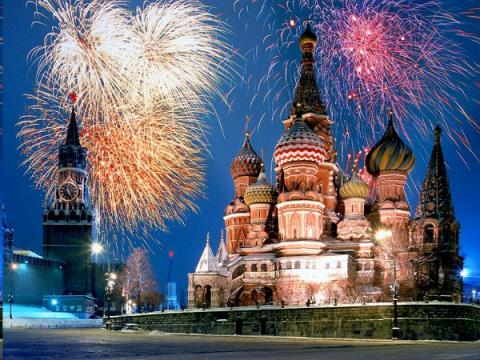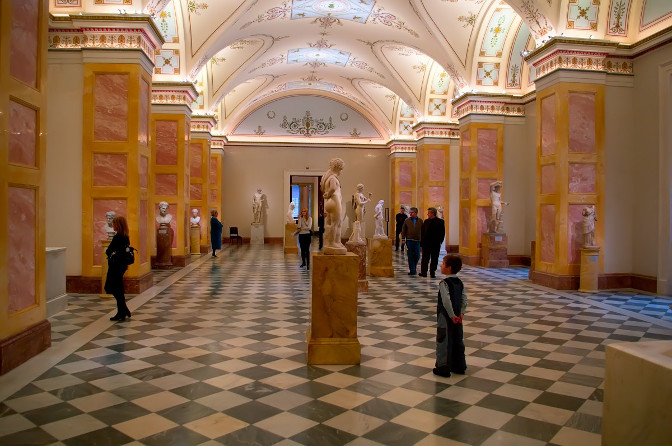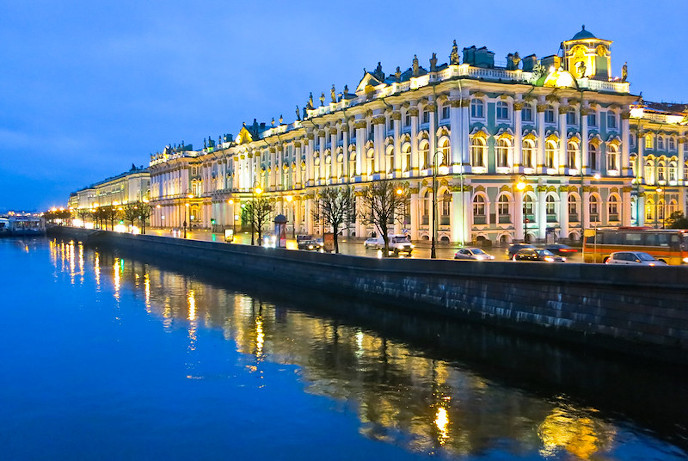Moscow vs. St. Petersburg: A Travel Guide with Literary Aspirations

“Moscow or St. Petersburg?”
If you’ve ever found yourself a foreigner in Russia, chances are you’ve been asked this question. After taking in the perfectly proportioned boulevards and neoclassical facades of St. Petersburg and the congested highways and architectural indecision of Moscow, you may have even attempted to answer it. In this country of “two capitals,” an outsider’s opinion provides valuable justification for a city-dweller’s pride.
Not that there’s any lack of it.
Each city was once the epicenter of an empire. St. Petersburg was the center of imperialist Russia from 1712 to 1917, though it was officially referred to as Petrograd following 1914 and Leningrad from 1917 to 1991. It is a European city, rich in visible history and overpriced cafes, but with a sadistic edge that can be attributed to its northerly climate.
Moscow, a citadel-turned-city, was the capital of early Tsarist Russia and later the Soviet Union. At present, the Russian Federation has its capital in Moscow, tucked away within the monolithic buildings of the Kremlin. At odds with the chain restaurants and office buildings, one can find Orthodox churches nestled throughout the city, surprisingly solemn despite their meringue-like spires and gold-leaf icing.
So how to answer the question?
If I have discovered one truth while living in Russia, it is that Russians are a literary people. The mysterious Russian soul does not lend itself to explanation, but does give itself to the steady meter of a poem or the gradual unfolding of a narrative.
A legacy of powerful and varied literature has helped natives and foreigners alike make sense of the “riddle, wrapped in a mystery, inside an enigma” as Churchill so aptly described the country. From Tolstoy to Bulgakov, Dostoevsky to Solzhenitsyn, the lives of people connected to Russia have been carefully transferred to the written word. From here, literary associations have served as both analysts of historic past and catalysts for new memories.
To truthfully answer this question, each city deserves to be observed first-hand and retold with its soul intact. This is not so much a travel guide or a reading list, as an account of experiences both read and lived.
Moscow, Sparrow Hills
"We stood on that eminence that overlooks the whole city and saw Moscow stretching to the horizon, a huge city. There were black piled clouds in the sky, but the sun shone underneath and glittered on the golden domes of the Kremlin. It is a city of great buildings, and little old wooden houses with wooden lace around the windows, a curious, moody city, full of character."
- John Steinbeck, A Russian Journal, Chapter 3
Steinbeck is not a logical start for an article on Russian cities and Russian literature.
In comparison to his American works, the author’s account of traveling in post-WWII Russia is not well-known. A Russian Journal is self-admittedly limited in scope but is nevertheless an honest account of Soviet Russia from the perspective of an American outsider. The idea for the trip came to Steinbeck out of a bout of curiosity he experienced while sitting at bar with war photographer Robert Capa. He writes, “It occurred to us that there were some things that nobody wrote about Russia, and they were the things that interested us most of all.” With his work, Steinbeck doesn’t attempt to philosophize or editorialize. He simply attempts to observe and does so with great skill.
Like Steinbeck, you may find yourself a foreigner in Russia with only a short amount of time to see the country. In that case, a panoramic view may help you get your bearings.
A visit to Sparrow Hills, known as Lenin Hills in Soviet or Steinbeck times, is worth the time. This scenic hillside park overlooks the entire city and provides the perfect location for shooting postcard-quality photos. Another perk will be seeing the city in its entirety and tracing the history of the city’s development. From the onion domes of the Novodevichy Convent (17th century) to the concrete bastions of the Olympic stadiums (famously boycotted in 1980), you can gain a sense of the many roles Moscow has played in Russia’s history.
To visit: Take the metro to the Vorob’evy Gory stop and walk along the foot bridge towards Moscow State University. Alternatively, many bus tours departing from the Kremlin include this location as one of their stops.

St. Petersburg, The Hermitage
“Musing in this manner, he walked on until he found himself in one of the principal streets of St. Petersburg, in front of a house of antiquated architecture. The street was blocked with equipages; carriages one after the other drew up in front of the brilliantly illuminated doorway. At one moment there stepped out on to the pavement the well-shaped little foot of some young beauty, at another the heavy boot of a cavalry officer, and then the silk stockings and shoes of a member of the diplomatic world. Furs and cloaks passed in rapid succession before the gigantic porter at the entrance.”
- Aleksandr Pushkin, ”The Queen of Spades”
From the unmistakably American Steinbeck, we move to the unmistakably Russian Pushkin. Alexander Sergeyevich Pushkin is the considered Russia’s greatest and most prolific poet, despite his early death in a duel at the age of 38. In honor of their national poet, Russians have attempted to use him as a default for naming things. There are streets, restaurants, metro stops, theatres, and art museums all named some variant of Pushkin. When a Russian child complains that they don’t want to eat their vegetables, Russian mothers usually retort, “Well, who’s going to eat them for you? Pushkin?”
In Pushkin’s short story, “The Queen of Spades,” a young Russian army officer learns the secret to winning any card game at the cost of his morality and, ultimately, his sanity. Just as Pushkin’s poem ultimately leads us to question the importance of outside appearances in comparison to the morality that lies within, St. Petersburg requires one to explore the interior of its majestic buildings. And certainly, no place will give you a better perspective on Russia’s imperial past than the Hermitage, a vast art museum situated in four different buildings on the Neva. The Hermitage owns the largest collection of paintings in the world, including a sizeable collection of Italian Renaissance, Dutch Golden Age, and French Impressionist art, of which only the choicest works are on display.
Overlooking the entire city of Moscow will give you a general impression of Russian history, wandering throughout the Hermitage will give you quite another.
To Visit: Get off at the Nevsky Prospekt station and follow Nevsksy Prospekt until you reach Dvorstoviy Prospekt. To your left you should see Dvorstoviy Ploschad and a large teal building, the Hermitage. Before going, I suggest watching the documentary Russian Ark, which takes you through 300 years of history and 33 rooms of the Hermitage in one continuous shot. It is the only feature film in history to be shot in a single take.
Moscow II, The Metro
I don't know why it is," responded Vronsky, "in all Moscow people—present company of course excepted," he put in jestingly, "there's something uncompromising. They are all on the defensive, lose their tempers, as though they all want to make one feel something..."
- Leo Tolstoy, Anna Karenina, Part 1, Chapter 17
In other parts of Russia, Muscovites have a reputation for being rushed, self-important, and uncaring. St. Petersburg residents, on the other hand, claim to be more laidback and civilized. While separating fact from fiction is too intricate a task for any one individual, Tolstoy is perhaps the only source authoritative enough to do justice to this myth. In Anna Karenina, both cities play a significant role in the novel’s plot. Anna Karenina herself lives in St. Petersburg but meets the fate-altering Vronsky at the Moscow train station during a trip to visit her brother. The theme of trains and the escape they represent factors in prominently in the peripatetic novel.
It would be difficult to consider the Moscow Metro an “escape” in the positive sense of the word. Rather, consider it a descent into the fast-paced reality of Moscow life and all its impressive trimmings. Distinguished by an art-deco style “M” lit by red lights, metro stations can be found in more than 100 locations throughout the city. When Stalin was designing the Moscow metro system, he took care that it would glorify the proletariat cause and reflect the bright future that he foresaw for Russia.
Futurism isn’t what comes to mind wandering these metro stations, however. Instead, an aesthetically pleasing combination of old-world artistry and Soviet idealism greet the eye. Finely crafted mosaics of ruddy Slavic farm maidens are framed in Baroque-style porcelain and lit by art-deco chandeliers. Scenes from Chekov plays are depicted in multi-hued marble and presided over by busts of Soviet heroes. For the finest examples of metro architecture, be sure to visit Komsomolskaya (coincidentally, where the train for St. Petersburg departs from), Beloruskaya, Kievskaya, and Teatralnaya. For Dostoevsky fans, a visit to the Dostoevskaya station, which features a bust of the famous writer and mural re-enacting scenes from his most famous works, is worth the brief excursion.
This is one respect in which St. Petersburg doesn’t even come close. Moscow is the Tsar of the modern metro.
To visit: Prepare your most expressionless face and head for any of the city’s hundred-plus metro stations. Fare is 28 rubles or a little under one dollar.

St. Petersburg II, Aleksandr Nevsky Monastery
“There are few places where there are so many gloomy, strong and queer influences on the soul of man as in Petersburg. “
-Fyodor Dostoevsky, Crime and Punishment, Chapter 34
Perhaps no author is more closely associated with St. Petersburg than Dostoevsky. It is surprising then that this son of Petersburg was actually born in arch-rival Moscow. While Moscow claims the birth of Dostoevsky, St. Petersburg claims much of his life and death. It is the setting for many of his most famous works, Crime and Punishment among them. Unlike most writers, Dostoevsky depicts St. Petersburg as a city of depravation and hypocrisy, a third party driving good people towards evil actions. After the elegant prose and otherworldly references of Pushkin, Dostoevsky adds a down-to-earth depth to our knowledge of this city.
Look no further for down-to-earth knowledge than the Aleksandr Nevsky monastery, the resting place of Dostoevsky and other famous sons of Petersburg. Among these are “The Five”— Glinka, Rimsky-Korsakov, Mussorgsky, Borodin, and Cui—Russian composers of the late 19th century who were famous for developing a unique, nationalist style. Tchaikovsky, the great man of Russian romantic music, can also be found here. He is guarded over by two angels, perhaps guarded from the harsh criticism of Cui, who wasn’t a big fan of his West-influenced work. Dostoevsky is buried under a more spartan tombstone - a simple marker with a bold stone cross on top. If a pilgrimage to the arts is on your agenda, this is certainly one location that cannot be missed.
To visit: Take the metro to Ploschad Aleksandra Nevskovo II. Follow Prospekt Obukhovskoy Oborony to the Monastery.
Moscow III, The Kremlin and the Red Square
"Moscow did not know what to attach herself to, whom to go and see, in order to live happily and normally. There was no joy for her in houses, she found no peace in the warmth of stoves or the light of table-lamps. She loved the fire that came from logs in stoves, and she loved electricity, but she loved them as though she herself was not a human being but that very same fire or electricity, the excitation of a force that brings about peace and happiness on earth."
- Andrey Platonov, Happy Moscow, Chapter 9
The home, heart, and hearth of Moscow is inevitably the Kremlin, the bolstered and glorified remnants of the citadel that was once capable of housing all its residents within its red and orange walls. The works of Andrey Platonov explore a Moscow many centuries older than the Kremlin. Just as the boundaries of Platonov’s Moscow are many miles past the Kremlin walls, his ideologies are a cosmos-bound Sputnik satellite in comparison to the medieval orthodoxy of Tsarist Russia.
The delicious thing about Platonov is his ability to pull off a Soviet naïveté that is both self-aware and sincere. The lead character in his unfinished novel, Happy Moscow, is the orphaned Moscow Chestnova who, in the words of scholar Eric Neiman is “a synecdoche for the metropolitan showcase…for the Soviet ideal as a whole”. Moscow is simultaneously Virgin, Whore, and Mother, an all-encompassing mass of aspirations and resignations that overwhelms all the other characters with her suffocating and untouchable idealism.
Just as Moscow forms the core of Platonov’s novel, drawing in all the other characters with its gravitational personality, the Kremlin and Red Square form the core of modern-day Russia. A conscious struggle to define Russian identity is currently going on behind its walls. While Lenin’s mausoleum still continues to draw hour-long queues in Red Square, efforts are being made to restore the Kremlin’s Russian Orthodox churches and palaces. Impersonators playing a diverse cast of characters from Russian history— from Catherine the Great to Stalin and even Putin— mull around the entrance to Red Square, vying for a place in history. At dark, light displays convert electricity into human awe and the camera clicks of shutter-happy tourists.
To Visit: Take the metro to Ploschad Revolyutsii or Teatral’naya stations. From there red brick and spires will lead the way.
St. Petersburg III, The Neva
“How often, when the sky was glowing,
by Neva, on a summer night,
and when its waters were not showing,
in their gay glass, the borrowed light
of Dian’s visage, in our fancies
recalling earlier time’s romances,
recalling earlier loves, did we,
now sensitive, and now carefree,
drink in the midnight benediction,
the silence when our talk had ceased!”
- Aleksandr Pushkin, “Eugene Onegin,” XLVII
“Eugene Onegin,” one of Pushkin’s most famous works, is an epic poem about a morally misguided nobleman who learns the error of his ways after losing the love of his life. The title character is born in St. Petersburg and often recalls the stately beauty of his birthplace. Though Moscow easily trumps St. Petersburg in terms of population, it is indisputably the aesthete among the two and the home of Russia’s aristocratic past.
To experience St. Petersburg fully, take a stroll along the river Neva, the lifeblood of the city. Peter the Great originally designed St. Petersburg to take after Amsterdam and Venice, incorporating numerous bridges and canals into its design. Walking alongside the Neva will take you past some of the city’s most historic buildings, including the Hermitage Museum and the Saint Peter and Paul Cathedral. During the warmer parts of the year, 22 of the city’s bridges are drawn nightly in order to allow ships to pass into the Baltic Sea. Though it’s possible to appreciate the Neva on foot, it is far more efficient and effective to see it by boat. Fortunately for visitors, boat tours are widely advertised and readily available.
To visit: Get off at the Nevsky Prospekt station and follow Nevsksy Prospekt until you reach Dvorstoviy Prospekt. Once you reach the riverside, you can walk along the length of Dvorstovaya Haberezhnaya, taking in the view. If you’re visiting in spring or autumn, take advantage of the latitude by sleeping in and capturing a few National Geographic-worthy shots when the sun rises. If you’re visiting in the summer, the famous White Nights will give you little opportunity for sunrise shots but will make up for it with late-night revelry.
Author Bio:
Nataliya Nedzhvetskaya is a contributing writer at Highbrow Magazine. Read her blog at http://zapadnik.wordpress.com.
Photo Credits: PeakPx (Creative Commons); Pxhere (Creative Commons); Ninara (Flickr, Creative Commons)






























































































































































































































































































































